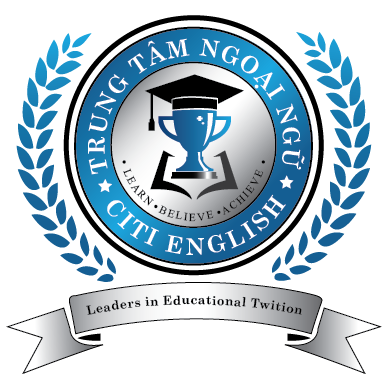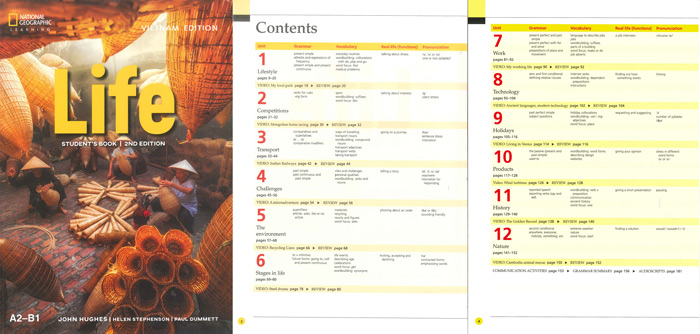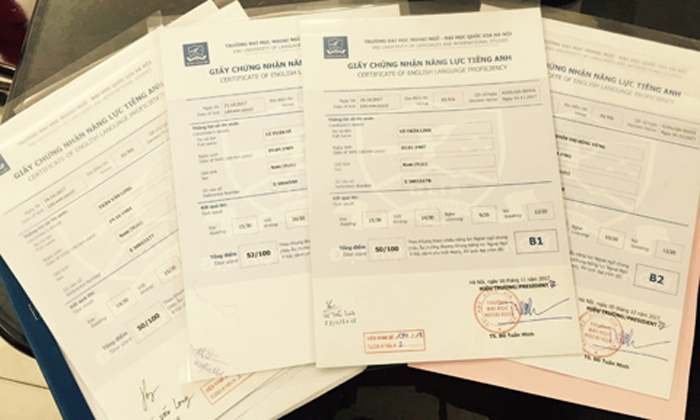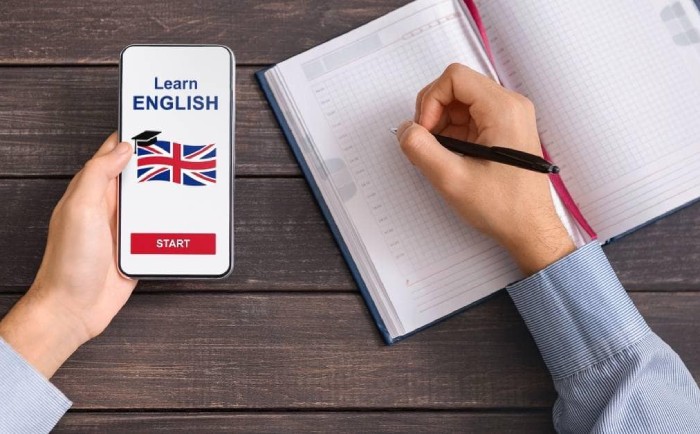Phần thi listening B1 Vstep có cấu trúc gồm 3 phần, với 35 câu hỏi trắc nghiệm. Thời gian làm bài thi là 40 phút, phần thi sẽ chiếm 25% tổng điểm bài thi Vstep.
- Part 1 – Dạng bài Short announcements/ Instructions (8 câu hỏi)
- Part 2 – Dạng bài Conversations (12 câu hỏi)
- Part 3 – Dạng bài Talks/ Lectures (15 câu hỏi)
Cấu trúc bài thi listening B1 Vstep
Phần thi nghe tiếng anh B1 Vstep là phần thi đầu tiên của đề thi tiếng anh B1, được sử dụng để đánh giá các kỹ năng nghe có độ khó từ B1 tới C1: Nghe hiểu thông tin chi tiết, thông tin chính, ý kiến, mục đích của người nói.
Cấu trúc bài thi gồm 3 phần, thời gian hoàn thành bài thi là 40 phút. Cụ thể:
|
Phần thi |
Cấu trúc |
Yêu cầu phần thi |
Thang điểm |
|
Part 1 |
8 câu hỏi |
Dạng bài Short announcements/ Instructions: Thí sinh nghe 8 thông báo, hướng dẫn ngắn (15-20 giây) và trả lời 8 câu hỏi trắc nghiệm tương ứng. |
0-4 điểm |
|
Part 2 |
12 câu hỏi |
Dạng bài Conversations: Thí sinh nghe 3 đoạn hội thoại (khoảng 1-3 phút) giữa 2 người (nam – nữ). Sau đó trả lời 4 câu hỏi trắc nghiệm tương ứng với mỗi đoạn. |
0-6 điểm |
|
Part 3 |
15 câu hỏi |
Dạng bài Talks/ Lectures: Thí sinh nghe 3 bài nói, bài giảng (khoảng 3 phút) và trả lời 5 câu hỏi tương ứng với mỗi đoạn |
0-15 điểm |
Học viên có thể tham khảo trích dẫn đề thi listening B1 Vstep dưới đây để nắm rõ cấu trúc:
PHẦN 1: NGHE HIỂU – VSTЕР
Thời gian: 40 phút
Số câu hỏi: 35
Directions: In this section of the test, you will have an opportunity to demonstrate your ability to understand conversations and talks in English. There are three parts in this section with special directions for each part. Answer all the questions on the basis of what is stated or implied by the speakers in the recording. There will be time for you to read the instructions and you will havea chance to check your work. The recording will be played ONCE only.
Time allowance: about 40 minutes, including 05 minutes to transfer your answers to your answer sheet.
PART 1: Questions 1-8
Directions: In this part, you will hear EIGHT short announcements or instructions. There is one question for each announcement or instruction. For each question, choose the right answer A, B, C or D. Then, on the answer sheet, find the number of the question and fill in the space that corresponds to the letter of the answer that you have chosen.
Now, let’s listen to an example. On the recording, you will hear:
Woman: Hello. This is the travel agency returning your call. You left a message about the holiday you’ve booked, asking which meals are included in the cost during your stay at Sunny Hotel. Lunch and dinner are free but if you wish to have breakfast in the hotel, you will need to pay an extra amount of money, depending on what you order. Let me know if I can help you with any other information. Goodbye.
On the test book, you will read:
Which meal is NOT included in the price of the holiday?
A. Breakfast B. Lunch C. Dinner D. All meals
The correct answer is A. Breakfast. Now, let’s begin with the first question.
Question 1: What is the announcement asking people to watch?
A. Their tickets B. Their flights
C. Their children D. Their luggage
Question 2: What is the time limit for this delivery service?
A. Fifteen minutes B. Thirty minutes
C. Forty minutes D. One and a half hour
Question 3: What can you do if you press “2”?
A. Cancel a reservation B. Confirm a reservation
C. Change a reservation lish for. D. Pay for a reservation
Question 4: What kind of vehicle was used to go to the first camping site??
A. A bus B. A truck
C. A jeep D. A van
Question 5: What percent of your income should you save?
A. 5 percent B. 10 percent
C. 20 percent D. 50 percent
Question 6: How long is the class on Saturday?
A. One hour B. Two hours
C. Six hours D. Eight hours
Question 7: Who are the furnished apartments popular with?
A. Elderly residents B. Single men
C. Young couples D. College students
Question 8: What does this health tip describe?
A. A step in good brushing B. How to brush your teeth
C. Choosing a good toothpaste D. Choosing a good toothpaste
PART 2: Questions 9-20
In this part, you will hear THREE conversations. The conversations will not be repeated. There are four questions for each conversation. For each question, choose the correct answer A, B, C or D.
Questions 9 to 12 refer to the following conversation.
Question 9: Who are the speakers?
A. Customer and salesperson C. Two Colleagues
B. Teacher and student D. Two university students
Question 10: What kind of furniture is mentioned in this conversation?
A. A cabinet B. A desk
C. A closet D. A bed
Question 11: What is the man’s problem?
A. His teachers are not friendly. C. His dorm room is so small.
B. His house is in bad condition. D. His college life is boring.
Question 12: What will they probably buy from the store?
A. A bed B. School supplies
C. A box D. Some books
Questions 13 to 16 refer to the following conversation.
Question 13: Where is the conversation most likely taking place?
A. In an office building B. In a meeting room
C. In a coffee shop D. In a parking lot B. At twelve o’clock
Question 14: When did they intend to meet each other?
A. At half past eleven B. At twelve o’clock
C. At half past twelve D. At one o’clock
Question 15: What can be inferred about Sam?
A. He already left. B. He does not drink coffee
C. He tried to call the woman. D. He has been late before.
Question 16: What will probably happen next?
A. The woman will talk with Sam. B. The woman will leave for the office.
C. They will go somewhere else. D. They will leave a message for Sam.
Questions 17 to 20 refer to the following conversation.
Question 17: What does the woman congratulate the man on?
A. His wife gave birth to a baby son.
B. His wife gave birth to a baby girl.
C. His wife gave birth to a boy and a girl. for Everyone
D. His wife gave birth to three babies.
Question 18: How is his wife after giving birth?
A. She is sleepless. B. She is quite weak.
C. She needs some rest. D. She is doing well.
Question 19: Who is his daughter going to be named after?
A. His wife B. His mother
C. His wife’s mother D. His godmother
Question 20: Where is the conversation probably taking place?
A. In the office B. In the coffee shop
C. At the man’s home D. At the bus station
PART 3: Questions 21-35
In this part, you will hear THREE talks, lectures or conversations. The talks, lectures, or conversations will not be repeated. There are five questions for each talk, lecture, or conversation. For each question, choose the right answer A, B, C or D.
Questions 21 to 25 refer to the following lecture.
Question 21: What is the main topic of the lecture?
A. The origin of the camera obscura B. Different types of early cameras
C. The life of Joseph Nicephore Niepce D. The history of early photography
Question 22: When was the first photograph created?
A. 1682 B. 1727
C. 1782 D. 1826
Question 23: What role did the study of optics play in the development of modern photography?
A. It led to the invention of the camera obscura.
B. It gave insight into the power of light.
C. It provided a scientific background for artists.
D. It helped develop photographic methods.
Question 24: According to the professor, what was the significance of Johann Schulze’s discovery?
A. It allowed the projection of images outside of a camera obscura.
B. It inspired other scientists to combine optics and chemistry.
C. It enabled photographers to capture images with light-sensitive material.
D. It demonstrated the ability to create light-sensitive images.
Question 25. What was the problem with Wedgwood’s photographs?
A. They were destroyed when exposed to light. B. They took a long time to produce.
C. They required expensive materials. D. They could not be reproduced.
Questions 26-30 refer to the following lecture.
Question 26: What is the lecture mainly about?
A. The common types of scheduling systems used by managers
B. The problems with conventional workday schedules
C. The advantages and disadvantages of a flextime scheduling system
D. The kinds of companies that benefit from flextime schedules
Question 27: Why does the professor mention school schedules?
A. To show other places that use flextime schedules
B. To liken a condensed schedule to a typical school day
C. To explain why flextime schedules were orginhaly created
D. To describe how flextime can be useful for working parents.
Question 28: If an employee chooses condensed schedule, he probably has to work _
A. 1 day a week B. 2 days a week
C. 4 days a week D. 5 days a week
Question 29: How many types of flextime schedule are there?
A. 1 C. 3
B. 2 D. 4
Question 30: According to the professor, how do companies benefit from offering flextime?
A. It gives managers flexibility when creating schedules.
B. It makes it easier to plan staff meetings.
C. It builds loyalty among workers.
D. It encourages employees to work harder.
Questions 31 to 35 refer to the following professor’s talk.
Question 31: What aspect of Mars does the professor mainly discuss?
A. Its seasonal similarities to Earth
B. How its weather patterns are changing
C. The basic characteristics of its climate
D. Its suitability for supporting life
Question 32: Why does the professor tell the students that Mars takes twice as long as Earth to
go around the sun?
A. To explain the length of Martian seasons
B. To demonstrate the differences between Earth and Mars
C. To argue that Mars has more than four seasons
D. To suggest that distance from the sun doesn’t affect temperatures
Question 33: According to the lecture, what is true about temperatures on Mars?
A. They vary less than temperatures on Earth.
B. They are below freezing at all times.
C. They change according to location and time.
D. They were probably colder in the past.
Question 34: What is the average wind speed on Mars?
A. Thirty-two kilometers per hour
B. Thirty-eight kilometers per hour
C. Ninety kilometers per hour
D. Ninety-six kilometers per hour
Question 35: What do scientists believe about dust storms on Mars?
A. They’re responsible for the long seasons.
B. They are affecting larger parts of the planet than in the past.
C. They’re related to extremely high wind speeds.
D. They’re occurring less frequently because of colder weather.
THIS IS THE END OF THE LISTENING PAPER.
NOW YOU HAVE 05 MINUTES TO TRANSFER YOUR ANSWERS TO YOUR ANSWER SHЕЕТ.
Hướng dẫn luyện nghe tiếng anh B1
Để luyện nghe hiệu quả, học viên cần nắm vững kiến thức ngữ pháp và từ vựng tiếng anh B1 để có thể hiểu nội dung bài nghe. Khi ôn tập, hãy kết hợp cả 2 phương pháp:
Luyện nghe chủ động (Active Listening)
- Chọn chủ đề phù hợp: Hãy bắt đầu với những chủ đề quen thuộc như du lịch, công việc, học tập – giúp dễ liên hệ và đoán nghĩa.
- Nghe có mục tiêu: Trước khi nghe, đọc qua câu hỏi hoặc tiêu đề để xác định thông tin cần tìm (who, what, when, why…).
- Kỹ thuật shadowing: Lặp lại theo người nói, chú ý ngữ điệu, trọng âm, và tốc độ nói. Phương pháp này giúp cải thiện đồng thời kỹ năng nghe – nói.
- Ghi chép thông minh: Không cần viết tất cả, chỉ ghi từ khóa và cụm từ thể hiện ý chính.
Luyện nghe thụ động (Passive Listening)
- Tạo môi trường tiếng Anh hằng ngày: Xem tin tức BBC Learning English, podcast “6 Minute English”, hoặc video phụ đề song ngữ.
- Nghe xen kẽ trong hoạt động thường ngày: Khi di chuyển, tập thể dục hoặc nấu ăn – mục tiêu là để tai làm quen với âm điệu tự nhiên.
Tối ưu hiệu quả luyện nghe
- Sau mỗi bài, nghe lại ít nhất 2 lần: lần đầu để hiểu tổng thể, lần sau để nhận diện chi tiết.
- Khi gặp từ mới, ghi lại cùng câu chứa từ đó, tránh học rời rạc.
- Mỗi tuần, chọn một bài nghe chuẩn định dạng B1 (VSTEP, Cambridge PET…) để kiểm tra khả năng nắm bắt thông tin
Ngoài ra, trong quá trình làm bài thi, học viên nên đọc qua toàn bộ câu hỏi để xác định thông tin cần tìm kiếm. Sau đó xác định từ khóa để dễ dàng tập trung vào nội dung cần nghe.
Đăng ký nhận tài liệu ôn thi tiếng anh B1 Vstep – Chuẩn định dạng format bài thi của Bộ Giáo dục
Download tài liệu luyện nghe tiếng anh B1
Trong quá trình luyện thi tiếng anh B1, học viên nên ưu tiên lựa chọn những tài liệu bám sát theo định dạng bài thi. Hãy tham khảo một số tài liệu dưới đây:
Đề thi nghe tiếng anh B1 Vstep Listening Part 1
- Part 1 listening B1 Vstep – Test 1
- Part 1 listening B1 Vstep – Test 2
- Part 1 listening B1 Vstep – Test 3
- Part 1 listening B1 Vstep – Test 4
Đề thi nghe tiếng anh B1 Vstep Listening Part 2
- Part 2 listening B1 Vstep – Test 1
- Part 2 listening B1 Vstep – Test 2
- Part 2 listening B1 Vstep – Test 3
- Part 1 listening B1 Vstep – Test 4
Đề thi nghe tiếng anh B1 Vstep Listening Part 3
- Part 3 listening B1 Vstep – Test 1
- Part 3 listening B1 Vstep – Test 2
- Part 3 listening B1 Vstep – Test 3
- Part 1 listening B1 Vstep – Test 4
Trên đây là toàn bộ thông tin về bài thi Listening B1 Vstep. Hy vọng những hướng dẫn luyện nghe mà trung tâm đã gợi ý sẽ giúp học viên hoàn thiện kỹ năng nghe trong thời gian ngắn. Chúc bạn thành công!






